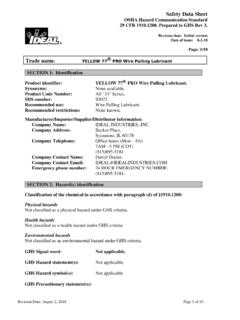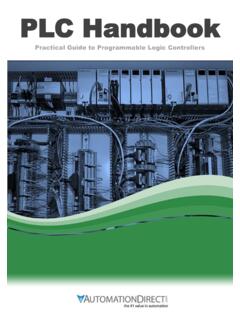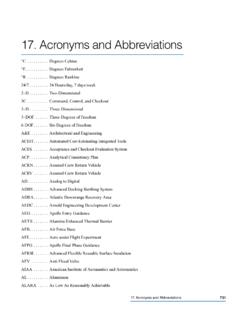Transcription of IDEAL INDUSTRIES INC.
1 1 IDEAL INDUSTRIES INC. The Basics of Digital Multimeters A guide to help you understand the basic Features and Functions of a Digital Multimeter. Author: Patrick C Elliott Field Sales Engineer IDEAL INDUSTRIES , Inc January 2010, Version 1 1 The Basics of Electricity To better understand digital multimeters, it s helpful to become clear on the basics of electricity. After all, DMMs always measure some aspect of electricity. Electricity passing through a conductor is similar to water flowing through a pipe. Every pipe has force that creates a certain pressure, causing water to flow. In the case of electricity, that force might be a generator, battery, solar panel or some other power supply. The pressure created by that power supply is called voltage.
2 Voltage is the pressure applied to the circuit. Current is the Flow of the electricity in the conductor. Resistance is any restriction to the flow of the current in a conductor. Voltage, current and resistance are the three most fundamental components of electricity. Voltage is measured in volts, current in amps and resistance in ohms.. Voltage, Current and Resistance Voltage is the pressure that is applied to a conductor. There are two common types of power sources, Alternating Current (AC) and Direct Current (DC). Alternating Voltage is the most common form of electricity. It is the power supplied by the utility or generators, which flows through our electrical circuits. The symbol for AC voltage is . DC Voltage is a constant level of stored energy. It is stored in batteries or converted from alternating voltage through the use of electronic rectifiers.
3 Electronic products like TVs, VCRs and computer equipment run on DC power. The symbol for DC voltage is . The three components in an electrical system are electrical pressure, or voltage (measured in volts), the amount of electricity flowing, or current (measured in amps), and impedances within the system, or resistance (measured in Ohms) A generator creates electricity from two opposite magnetic fields, as the wire turns between these two fields, electrons are pulled first in a positive, then in a negative direction 2 Current is the flow of electricity through a conductor. As with voltage, there are two types of current, AC and DC. The symbol for current is the letter A. The third component is resistance, measured in Ohms. Resistance in the circuit impedes the flow of current through a conductor.
4 The symbol for resistance is the Greek Omega, , sometimes referred to as the horseshoe. Ohm s Law Together, voltage, current and resistance comprise Ohm s Law. Ohm s Law is an important equation for electricians. By using a DMM, they can establish values for the three variables which help in diagnosing electrical problems. Ohm s Law can be expressed in equation form in this way: Tech Note: Voltage determines the flow of current; the greater the voltage, the greater the current. If resistance is increased, the current will decrease. Lower the resistance, and current will increase. The relationship of these three elements of Ohm s Law; Volts, Ohms and Amperes, must mathematically balance. Let s take an example; say we have a 120 Volt outlet and a hair dryer. If the hair dryer is set on low, it would draw 7 amps.
5 The load resistance is around 17 , but if we change the setting to high, the current draw would increase to 12 amps, and the load resistance will decrease to 10 . For useful formulas See Appendix A Unlike alternating voltage, direct voltage is a steady flow of positive energy. It is commonly stored in batteries for use in electronic equipment. Ohm s Law is expressed in an equation: V=A x If Ohms ( ) increase, current (A) decreases, and if Current (A) increases, Ohms ( ) decreases 3 Electrical Circuits In an Electrical system, there are two ways that loads are connected in a circuit, in Series or in Parallel. In a Series Circuit, each device is connected together in a line. Current flows through each device connected to the circuit. If you were to increase the resistor in the Series Circuit shown below, the light would dim.
6 You have restricted the flow or available current to the light. In Parallel Circuit, the same amount of voltage is applied to each device. Current can flow freely through each device without affecting another. Our homes are wired in Parallel for this reason. When making measurements with a digital multimeter, it is important to remember that Voltage measurements are made with the test leads connected in Parallel, and Current measurements are made with the test leads connected in Series. Tech Note: The number one mistake made when using modern multimeters is to try and measure voltage with the test leads in the current input jacks. The input impedance of the current inputs jacks is in the range of ohm to around 8 ohms, depending on the manufacturer. This low impedance is like a short circuit when making a voltage measurement.
7 Because of this low resistance and possible short circuit condition most multimeters current input jacks are fused for protection. Well constructed meters will use a high energy fuse for this protection but you will blow the fuse if you test in this manner. In a series circuit, loads within the circuit have an impact on the flow of electricity to the other loads. In a parallel circuit, loads within the circuit will not impact the flow of electricity to the other loads. 4 Types of Multimeters There are two common types of Multimeters, Analog and Digital. Digital Multimeters (DMMs) are the most common. They use a liquid crystal display (LCD) technology to give more accurate readings. Other advantages include higher input impedances, which will not load down sensitive circuits, and input protection.
8 Analog meters use a needle movement and calibrated scale to indicate values. These were popular for years, but recently their numbers have declined. Every voltmeter has an internal resistance or impedance. The input impedance of an analog meter is expressed in Ohms per Volt Tech note: Analog meters The internal impedance of the meter is in parallel to the measured circuit. You want this impedance to have as little effect on the measurement as possible so the higher the impedance the better. For most electrical measurements this effect is minimal, but for sensitive electronics of today the effect of the added resistance could be significant. This is just one of the disadvantages of an Analog meter. There are however a few useful applications for analog meters , so they aren t going away tomorrow.
9 The Digital Multimeter (DMMs) feature a digital or liquid crystal display (LCD). Measurement readings are displayed as numerical values on the LCD Display. The display also alerts you to any pertinent symbols and warnings. Tech Note: Digital Multimeters and ClampMeters use different techniques internally, to measure AC, DC voltage, Resistance and Amperes. An advantage of a digital multimeter is their accuracy and input protection. Their input resistance or impedance is very high, in the range of 1,000,000 to 10,000,000 ohms, so there is little effect on the measurement. On good quality meters , their inputs are also protected from faults and misuse. Test instruments today devote a good deal of architecture to overload protection. Most digital The input impedance of an analog meter is expressed in Ohms per Volt In this example the impedance for AC volts is 5000 ohms per volt.
10 If I want to measure 120 Vac the input resistance would be 5000 x 120 or 600,000 ohms. 5 meters meet some safety standard such as UL601010 or IEC (International electro -technical Commission). DMMs at a Glance The port panel is where you plug in your test leads. The diagram below explains where the test leads go for specific tests. Multimeter Safety When making a meter selection look for a tester that is independently certified to some safety standard, UL, IEC, CSA. Pay close attention to how and where you are using the equipment. Never use equipment that is outside of its manufacturer specified measurement range, or outside of its category rating. Over Voltage Category Description of Category CAT IV Primary supply, Overhead or underground utility service. CAT III Distribution level mains, fixed installation CAT II Local level mains, appliances, portable equipment.








